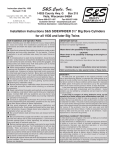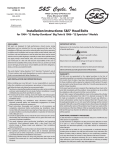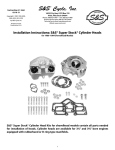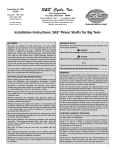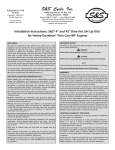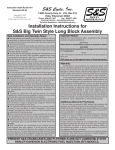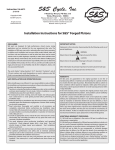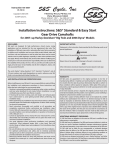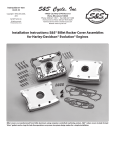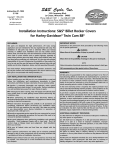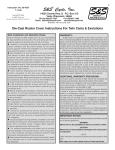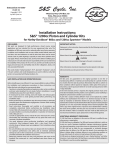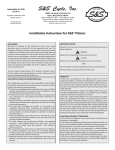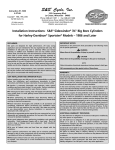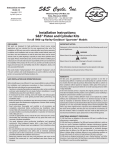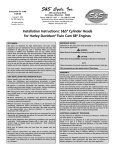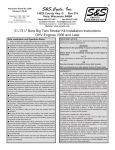Download - S&S Cycle
Transcript
S&S Cycle, Inc. ® Instruction 51-1114 5-10-06 Copyright © 2002, 2006 by S&S Cycle, Inc. All rights reserved. Printed in the U.S.A. 235 Causeway Blvd. La Crosse, Wisconsin 54603 Phone: 608-627-1497 • Fax: 608-627-1488 Technical Service Phone: 608-627-TECH (8324) Technical Service Email: sstech@sscycle.com Website: www.sscycle.com Because every industry has a leader Installation Instructions: 106” S&S® Stroker Kits for Harley-Davidson® Twin Cam 88® Engines DISCLAIMER: IMPORTANT NOTICE: S&S parts are designed for high performance, off road, racing applications and are intended for the very experienced rider only. The installation of S&S parts may void or adversely effect your factory warranty. In addition such installation and use may violate certain federal, state, and local laws, rules and ordinances as well as other laws when used on motor vehicles used on public highways, especially in states where pollution laws may apply. Always check federal, state, and local laws before modifying your motorcycle. It is the sole and exclusive responsibility of the user to determine the suitability of the product for his or her use, and the user shall assume all legal, personal injury risk and liability and all other obligations, duties, and risks associated therewith. Statements in this instruction sheet preceded by the following words are of special significance. The words Harley®, Harley-Davidson®, H-D®, Sportster®, Evolution®, and all H-D part numbers and model designations are used in reference only. S&S Cycle is not associated with Harley-Davidson, Inc. SAFE INSTALLATION AND OPERATION RULES: Before installing your new S&S part it is your responsibility to read and follow the installation and maintenance procedures in these instructions and follow the basic rules below for your personal safety. ● Gasoline is extremely flammable and explosive under certain conditions and toxic when inhaled. Do not smoke. Perform installation in a well ventilated area away from open flames or sparks. ● If motorcycle has been running, wait until engine and exhaust pipes have cooled down to avoid getting burned before performing any installation steps. ● Before performing any installation steps disconnect battery to eliminate potential sparks and inadvertent engagement of starter while working on electrical components. ● Read instructions thoroughly and carefully so all procedures are completely understood before performing any installation steps. Contact S&S with any questions you may have if any steps are unclear or any abnormalities occur during installation or operation of motorcycle with a S&S part on it. WARNING Means there is the possibility of injury to yourself or others. CAUTION Means there is the possibility of damage to the part or motorcycle. NOTE Other information of particular importance has been placed in italic type. S&S recommends you take special notice of these items. WARRANTY: All S&S parts are guaranteed to the original purchaser to be free of manufacturing defects in materials and workmanship for a period of twelve (12) months from the date of purchase. Merchandise that fails to conform to these conditions will be repaired or replaced at S&S’s option if the parts are returned to us by the purchaser within the 12 month warranty period or within 10 days thereafter. In the event warranty service is required, the original purchaser must call or write S&S immediately with the problem. Some problems can be rectified by a telephone call and need no further course of action. A part that is suspect of being defective must not be replaced by a Dealer without prior authorization from S&S. If it is deemed necessary for S&S to make an evaluation to determine whether the part was defective, a return authorization number must be obtained from S&S. The parts must be packaged properly so as to not cause further damage and be returned prepaid to S&S with a copy of the original invoice of purchase and a detailed letter outlining the nature of the problem, how the part was used and the circumstances at the time of failure. If after an evaluation has been made by S&S and the part was found to be defective, repair, replacement or refund will be granted. ADDITIONAL WARRANTY PROVISIONS: ● Consult an appropriate service manual for your motorcycle for correct disassembly and reassembly procedures for any parts that need to be removed to facilitate installation. (1) S&S shall have no obligation in the event an S&S part is modified by any other person or organization. ● Use good judgement when performing installation and operating motorcycle. Good judgement begins with a clear head. Don't let alcohol, drugs or fatigue impair your judgement. Start installation when you are fresh. (2) S&S shall have no obligation if an S&S part becomes defective in whole or in part as a result of improper installation, improper maintenance, improper use, abnormal operation, or any other misuse or mistreatment of the S&S part. ● Be sure all federal, state and local laws are obeyed with the installation. ● For optimum performance and safety and to minimize potential damage to carb or other components, use all mounting hardware that is provided and follow all installation instructions. (3) S&S shall not be liable for any consequential or incidental damages resulting from the failure of an S&S part, the breach of any warranties, the failure to deliver, delay in delivery, delivery in non-conforming condition, or for any other breach of contract or duty between S&S and a customer. ● Motorcycle exhaust fumes are toxic and poisonous and must not be inhaled. Run motorcycle in a well ventilated area where fumes can dissipate. (4) S&S parts are designed exclusively for use in Harley-Davidson® and other American v-twin motorcycles. S&S shall have no warranty or liability obligation if an S&S part is used in any other application. Introduction Installation of the S&S® 37⁄8” bore Stroker kit for Harley-Davidson® Twin Cam 88® engines is relatively straight forward. Assembly Procedures for the S&S Stroker kit are essentially the same as for assembly of a stock engine. In addition, a torque plate kit, part number H-D® #39786, is available from Kent-Moore, through Harley-Davidson, for fitting the S&S 37⁄8” bore pistons to stock Twin Cam 88 cylinders. All reference to Harley-Davidson® part numbers is for identification purposes only. We in no way are implying that any of S&S® Cycle’s products are original equipment parts or that they are equivalent to the corresponding Harley-Davidson® part number shown. NOTE- The 106” kit requires stroker flywheels which are included with the kit. S&S® flywheels for Twin Cam 88® engines are supplied assembled and balanced. The procedure for installing an S&S flywheel assembly is the same as for stock flywheels. Installation Steps 1. Prepare camside crankcase. 2. Check internal engine clearances and assemble crankcases. 3. Final assembly. 4. Engine break-in procedure. Installation 1. Prepare Camside Crankcase A. Refer to appropriate service manual. Remove engine from frame. Disassemble engine and split crankcases. B. Temporarily install cams to be used in camside crankcase. Refer to S&S cam installation instructions. Turn cams at least one full rotation, and note any clearance problems between the cam lobes and the crankcase. Pay particular attention to pinion bearing boss and tappet guide boss areas. C. Machine material from crankcase to achieve .030” clearance between cam lobes and crankcase. See Picture 1 & 2. Picture 1 CAUTION Clearance between cam lobes and crankcase must be checked at pinion bearing boss and tappet guide boss. Machine case to achieve .030” minimum clearance. D. 2. Install piston oiler kit, S&S Part #31-2026. Lubricate oring with engine oil. Apply Loctite® 243 to threads of machine screws. Install and torque to 25 in-lbs. See Picture 3. Check internal engine clearances and assemble crankcases. Many clearance checks can be made at the same time that some assembly steps are performed. This can save time for the engine builder. A. Cylinder to piston fitment. 1. 2. 3. 4. The 106” Stroker 37⁄8” bore pistons, S&S piston series 92-1210, require a clearance of .002”-.0025” to cylinder bore. S&S recommends that torque plates be installed on cylinders when boring and honing to achieve proper fitment tolerance. Identify front and rear pistons. The rear piston will have a notch machined into the piston skirt for clearance with the front piston. This notch must face the center of the engine, towards the front of the motorcycle. Check piston ring gap. Install piston ring into finished cylinder and square-up ring to bore using the piston. The required ring gaps are as follows: Top two compression rings .016” - .022” Oil control rings (rails) .015” - .035” File or grind ring ends as necessary to establish proper end-gap. Wash finished cylinder in hot, soapy water to remove honing abrasive from cylinder bore. Rinse with clean water and apply a light oil to the bore to prevent rust. Picture 2 Clearance between cam lobes and crankcase must be checked at pinion bearing boss and tappet guide boss. Grind or machine case to achieve .030” minimum clearance. 2 Picture 3 CAUTION Cylinders that have not been cleaned with soap and hot water will release abrasive into the oil as the engine reaches operating temperature, resulting in accelerated wear of internal engine components, greatly reducing engine life. Picture 4 NOTE - If clearancing is required. Tape off the pinion and cam bearings to prevent chips from getting into bearings. D. Piston to piston clearance. 1. B. Piston to head clearance, 1. 2. Install flywheel assembly in right crankcase only. Assemble pistons without rings on their proper connecting rods. Installation of wristpin clips is not necessary. NOTE - A minimum of .060” clearance is required between pistons at the closest point. 2. NOTE - Rear piston has piston to piston clearance notch machined in piston skirt, place notch toward center of engine. 3. 4. Install both cylinders and temporarily secure each with one nut. Rotate flywheel to position where pistons are at TDC. Piston deck should be flush with cylinder head gasket surface. NOTE - The stroker engine is designed with .045” piston to head clearance (squish), which is provided by thickness of head gasket. Therefore, pistons at TDC should be flush with head gasket surface of cylinders. If pistons are higher than cylinders at TDC, then something is wrong and S&S® should be notified. Rotate flywheel to position where pistons are closest to each other. See Picture 5. Check clearance between pistons. E. If additional clearancing is needed, disassemble cylinders and pistons and carefully file edge of piston skirts until clearance is obtained. Clean all parts. Piston to piston oiler clearance. This step can be done at the same time as Step C above. 1. 2. 3. 4. Rotate flywheel to position where rear piston is at bottom of travel. Check clearance between piston skirt and piston oiler. See picture 6. Repeat for front piston. If clearance between piston skirts and piston oilers is less than .060”, file notch in piston skirt to achieve required clearance. CAUTION Insufficient clearance between piston domes and cylinder heads will damage pistons, heads and/or other engine components. C. Connecting rod to crankcase clearance. 1. 2. Rotate flywheel to positions where connecting rods are closest to crankcase and cylinder spigots in front and rear. There must be a minimum of .060” clearance between connecting rods and crankcases or cylinder spigots. See Picture 4. Clearance crankcases or cylinder spigots if needed. Connecting rod to crankcase clearance is usually not a problem with S&S Stroker kits, but if engines are built with longer strokes or heavier connecting rods a potential for contact exists. Picture 5 3 H. Check Valve to piston clearance at TDC. 1. 2. Picture 6 F. Assemble lower end - final assembly. 1. 2. Disassemble cylinders and pistons. Remove flywheel assembly from right crankcase. Clean all lower end parts for final assembly. NOTE - Cleaning parts prior to and during assembly and keeping parts clean after final assembly are imperative to minimize contaminants that may circulate in oil and shorten engine life. Many parts can be cleaned with soap and water first. Then, reclean all internal parts and gasket mating surfaces using high quality solvent that does not leave any harmful residues. 3. 4. 5. G. Install flywheel assembly. Follow factory procedure. Bolt crankcases together. Use S&S® torque specs for crankcase bolts. Torque case bolts in two stages to 10 ft-lb. and finally 15 ft-lb. in the sequence shown in Figure 1. Assemble gear case components. Follow S&S instructions if installing S&S gear drive cams. Follow factory procedures for all other components. Spread layer of putty into valve pockets in both pistons. Assemble cylinder heads and bolt on cylinders with head gaskets in place. Install rocker covers and pushrods. Adjust pushrods so the hydraulic piston in tappet is bottomed in the tappet bore or on the HL2T washer if used. This insures that tappets can not bleed down so valve position will be accurate for clearance check. NOTE- The earlier Harley-Davidson® Twin Cam 88® lifters, H-D® part numbers 18538-99 & 99A, require the S&S HL2T kit number 33-5339. Later lifters, H-D® part number 18538-99B, require the S&S HL2T kit number 33-5338. Both kits are included with the stroker engine kits, and either kit is installed & adjusted the same way - remove the retaining clip from the top of the lifter, and remove the piston assembly and spring from lifter body. Place the appropriate HL2T travel limiter into the bore of the lifter and replace removed components in the order that they were removed. See Picture 7. All reference to Harley-Davidson part numbers is for identification purposes only. We in no way are implying that any of S&S® Cycle’s products are original equipment parts or that they are equivalent to the corresponding Harley-Davidson part number shown. 3. 4. Turn engine over in normal direction of travel two complete revolutions. Disassemble engine and check thickness of putty in valve pockets. Check valve pocket fit. 1. 2. 3. 4. 5. 6. 7. Install pistons without piston rings on correct connecting rods. Install cylinders. Turn engine over until piston in front cylinder is at top dead center. Paint area around valve pockets on pistons with machinist’s blue. Place valves in cylinder head leaving off springs and retainers. Place head on cylinder and secure with one bolt. Lower valves until they contact piston. Rotate valve, marking painted area. Remove head and check points of contact. Valve should fit in valve pocket machined in piston dome. If insufficient clearance exists, remove piston and machine valve pocket until head of valve fits flush. Repeat procedure for other cylinder head. Torque In Sequence Shown In Two Stages. Stage 1 - 10 ft-lb. Stage 2 - 15 ft-lb. 9 4 6 2 7 5 8 Figure 1 4 3 1 NOTES: ● S&S® recommends at least .060” clearance around periphery of valve. ● S&S recommends at least .060” clearance between intake valve and piston valve pocket recess, and .080” between exhaust valve and piston valve pocket recess. ● When checking valve to piston clearance pushrods must be adjusted so the hydraulic piston in tappet is bottomed in the tappet bore or on the HL2T washer if used. This insures that tappets can not bleed down so valve position will be accurate for clearance check. CAUTION Insufficient clearance between piston and valves may cause them to contact each other during operation resulting in damage to piston and valve train components. 5. 6. 3. If insufficient clearance exists, machine piston until proper clearance is achieved. Disassemble top end and clean all parts for final assembly. CAUTION Manufacturing chips, dirt and/or other contaminants circulating in engine oil may possibly damage engine components resulting in shorter engine life and possible engine failure. WARNING ● Some solvents, degreasers and other chemicals are harmful to skin, eyes and other body parts. Many items are flammable and present a fire hazard. Read manufacturer’s instruction label for proper use. Use in well ventilated area and wear protective clothing when using them to avoid personal injury. ● Compressed air and particles dislodged by compressed air are harmful to eyes and body. Wear protective goggles when using compressed air and always direct air stream away from yourself and other people near you. A. Head gasket surface flatness check. Before top end is assembled, head gasket to cylinder mating surfaces should be checked. Final assembly. NOTE - Cleaning parts prior to and during assembly and keeping parts clean after final assembly are imperative to minimize contaminants that may circulate in oil and shorten engine life. Many parts can be cleaned with soap and water first. Then, reclean all internal parts and gasket mating surfaces using high quality solvent that does not leave any harmful residues. CAUTION Incomplete contact between gasket surfaces of cylinders and cylinder heads may cause combustion leakage possibly resulting in damage to cylinders and/or other engine components. 1. Be sure to read and follow manufacturer’s instruction label before use. Use drill bits and compressed air to clean all oil passageways of dirt, filings, etc. whenever possible. All iron or steel parts should be coated with engine oil immediately after cleaning to prevent rust. During actual final assembly, recoat all internal parts with high quality engine oil. 2. 3. 33-5339 Thoroughly clean head and cylinder gasket surfaces. Place straight edge across head gasket surface at different places around diameter to determine flatness. If unevenness is revealed, machine head gasket surface just enough to make complete contact. 18539-99A 18539-99B 33-5338 Picture 7 5 CAUTION Improper torquing sequence and head bolt torque values may cause head gasket failure. 6. Bolt heads on cylinders. Follow the stock bolt tightening sequence, and use stock three stage procedure and torque values shown in Figure 2. See Figure 2. IMPORTANT NOTE - Proper first time engine start-up and breakin is critical to achieve permanent and lasting head gasket seal. Follow “Engine Break-In” procedures at end of section. CAUTION Picture 8 B. Top end assembly procedure. 1. 2. Thoroughly clean all top end parts and blow dry with compressed air. Use high grade lacquer thinner on gasket surfaces. Apply an assembly lube to the wristpin and wristpin bushing in the connecting rod. Install pistons on connecting rods, keeping note of proper placement and orientation. Install piston rings. a. Install oil ring support rail in the bottom of the oil ring groove. See Picture 8. b. Install oil ring separator and the oil control rings. c. The plain cast ring is to be installed in the second ring groove, dot facing up. d. The chrome-faced ring is to be installed in the top ring groove, either side up. Install wristpin retaining clips. NOTE - S&S® recommends the use of clip installer, part number H-D® 42317, available from Kent-Moore, through HarleyDavidson®, or similar tool, for clip installation. All reference to Harley-Davidson® part numbers is for identification purposes only. We in no way are implying that any of S&S® Cycle’s products are original equipment parts or that they are equivalent to the corresponding Harley-Davidson® part number shown. 3. 4. 5. Coat piston skirts with engine oil and install cylinders. Install head gaskets dry. Be sure head gaskets are properly positioned. Before installing heads spin each head bolt down on its respective stud to be sure threads are clean and free of contamination. Place a drop or two of oil on threads and under head of each head bolt just prior to final assembly. NOTE - Light coating of oil on head bolt threads minimizes friction so torque values will not be distorted. It cannot be emphasized enough that these steps must be done carefully. Maintaining a good head gasket seal depends on it. Improper first time engine start-up and break-in procedure may cause head gasket failure. 7. Finish assembling top end per Harley-Davidson® specs. Install pushrods and adjust. NOTE - The earlier Harley-Davidson Twin Cam 88® lifters, H-D® part numbers 18538-99 & 99A, require the S&S HL2T kit number 33-5339. The later lifters, H-D® part number 18538-99B, require the S&S HL2T kit number 33-5338. Both kits are included with the Stroker engine kits, and either kit is installed & adjusted the same way - remove the retaining clip from the top of the lifter, and remove the piston assembly and spring from lifter body. Place the appropriate HL2T travel limiter into the bore of the lifter and replace removed components in the order that they were removed. To adjust pushrod, rotate engine until the lifter is at its lowest point, collapse the lifter with the pushrod until it bottoms against the travel limiter, and then shorten the pushrod one complete turn (6 flats of the adjuster). Tighten the locknut of the pushrod adjuster. Repeat for remaining pushrods. NOTE - If S&S compression releases are to be installed, it is much easier to install them before rocker covers are installed and the engine is installed in the frame. S&S die-cast rocker covers for Harley-Davidson Twin Cam 88 or similar rocker covers with a center hole must be used if S&S electric compression releases are to be installed. Top View Driveside 2 1 Rear Head 3 4 1 2 Front Head 4 Camside S&S® Heads or Stock Heads Stage 1 7 Ft.-Lbs. Stage 2 14 Ft.-Lbs. Stage 3 Turn additional 90˚ Figure 2 6 3 8. Clean oil tank and oil cooler, if applicable, and flush or replace oil lines before installing engine in frame. CAUTION If engine is run with foreign material in the oil tank, engine damage will occur. Engine damage caused by foreign material in the oil tank is not covered under the S&S® warranty. 4. CAUTION Lugging or running engine prematurely at sustained high rpm may result in damage to pistons and other engine components. S&S voids its guarantee if engine is not broken in properly. G. For the balance of the first 1000 miles the motor can be run in a normal but conservative manner. You can be more liberal with the rpm range and motorcycle can be operated at normal highway speeds. Avoid overheating or putting any hard strain on the engine: no drag racing, dyno runs, excessive speed, trailer towing or sidecar operation. H. After 1000 miles, verify carburetor jetting and adjustment. Change the engine oil. Motorcycle can now be operated normally. I. Have Fun! Engine break-in procedure. NOTE - S&S engines are designed for high performance and as such are not tolerant of inadequate break-in. Correct break-in will assure longer engine life and will prevent unnecessary engine damage. Engine damage caused by improper break-in is not covered under the S&S warranty. A. Initial start up. Run engine approximately one minute at 1250-1750 rpm. DO NOT crack throttle or subject to any loads during this period as head gaskets are susceptible to failure at this time. During this time, check to see that oil pressure is normal, that oil is returning the oil tank, and that no leaks exist. B. Shut off engine and thoroughly check for any leaks or other problems. Let engine cool to the touch. C. After engine has cooled, start up again and allow the motor to build some heat. Engine should be run no longer than three to four minutes. When the cylinders become warm/hot to the touch (approximately 150°) shut the motor down and let it cool to room temp. Follow the same cautions as for the initial start-up, and continue to watch for problems. D. Repeat this procedure 3 or 4 times. Each successive time it should take slightly longer to warm up and you can increase the temp slightly each time (+10°). You can be more liberal each time with the rpm, gently vary rpm continuously from idle up to 2500 rpm in the final cycle. Don’t be too concerned with final carb settings at this time because idle speed and mixture cannot be correctly set until the motor reaches full operating temperature. The motor should not reach that temperature during these cycles. Do not allow engine temperature to become excessive. After the motor has cooled to room temperature for the final time you are ready to start the 1000 mile engine break-in process. E. The first 50 miles are most critical for new rings and piston break-in. Engine damage is most likely to occur during this period. Keep heat down by not exceeding 2500 rpm. Avoid lugging the motor, riding in hot weather or in traffic. Vary the engine speed. Do not lug the engine. We recommend changing the oil at 50 miles. F. The next 500 miles should be spent running engine no faster than 3500 rpm or 60 mph. Avoid continuous steady speeds, and do not lug the engine. Vary engine rpm. We recommend changing the oil again at 500 miles. Performance Notes: ● Ignition system - S&S engine kits for Harley-Davidson® Twin Cam 88®, we recommend that an aftermarket or high performance ignition module be used. Engines built with S&S kits have higher than stock compression ratios, performance cams, and in some cases cylinder heads with combustion characteristics that are different from stock. These and other factors effect the ignition requirements of the engine. Programmable ignition systems allow ignition maps to be optimized for a specific application, but should be programmed by a qualified technician. Consult the ignition manufacturer for recommendations regarding use of a specific ignition system with large displacement high compression engines. ● Spark plugs - Use spark plugs and wires that are compatible with the ignition system. Dual plug installations in S&S Super Stock® heads are not generally necessary. ● All S&S test engines are run using S&S carburetors. S&S Super E and G carburetors are recommended for most applications with the Super G being used more often on larger displacement, freer breathing engines with higher compression ratios. Typically, engines equipped with S&S heads require the same or slightly leaner jetting than those engines fitted with stock heads. Consult the carburetor jetting instructions for specific jetting recommendations. ● If another type carburetor is used, it must be made to run rich enough to operate properly and to prevent engine damage. If you have a problem with another carburetor, S&S cannot help you and recommends you call the carb manufacturer with any questions you may have. ● If the motorcycle is used exclusively on a drag strip where engine temperatures vary, slightly richer jets may be necessary for best performance. Larger jets/richer mixtures will enable one to run a colder engine which is sometimes desirable. This is best determined by experimentation. 7 Performance notes, continued ● Carburetor jetting and spark plug color - While spark plug color may be used to help determine carburetor jetting, S&S® recommends that our instructions be used as primary jetting guide and that plug color indications be used only as secondary aid. We have found that different brands of gasoline, gasoline additives, engine heat (due to ignition timing), and brands of plugs and heat range used distort plug color drastically making plug reading difficult for the average tuner. Also, new plugs usually require a road test of 10 miles or more to properly develop the color which means that quarter mile tests may not be long enough and hence, not always a good indication of carb jetting. It is best to use recommended spark plug type and to consult the spark plug manufacturer if you have questions. Exhaust Systems ● Drag pipes - While drag pipes can be used with good results to achieve top end horsepower, they are generally not recommended for street applications. Carburetor adjustment and jetting is generally easier for engines with muffled exhaust systems. ● Muffler systems: Most stock and many aftermarket exhaust systems are too restrictive and made exclusively for looks with little consideration given to performance. A very good, economical street system consists of the stock header pipes with the crossover tube and a set of low restriction S&S mufflers. These mufflers work very well in most situations and offer an inexpensive alternative to a whole new exhaust system. Low restriction S&S mufflers and stock header pipes will typically produce 10 hp more than drag pipes in the midrange. Since the midrange is where the vast majority of normal riding occurs, it makes this system ideal for the street. Gearing ● Gearing depends on the total weight of the machine and rider, the size of the engine, cam, exhaust system and type of riding to be done. Most high performance engines, and particularly those with larger displacements, are capable of pulling more gear. We suggest you break the engine in with stock gearing to minimize the load on the engine. After the engine is broken in, you will have a better feel of its potential and can change gearing accordingly. ● For those who wish to determine their final drive gear ratio the formula is as follows: Engine Revolutions per One Revolution of Rear Wheel= (Clutch Sprocket*) x (Rear Wheel Sprocket*) (Motor Sprocket*) x (Transmission Sprocket*) * Number of teeth on each sprocket. Compression ● Generally speaking, while engines with higher compression ratios make more horsepower and perform better, they also tend to lose that performance edge faster, require more maintenance, are harder to start, and require better gasoline. As a rule, we recommend a compression ratio of no greater than 11:1 for engines used in normal street operation. A word of caution is in order. Before building an engine that may be unsuitable for your application, carefully consider your riding needs, riding style and overall performance objectives. Because every industry has a leader 8









